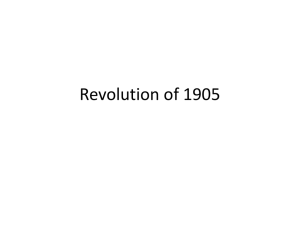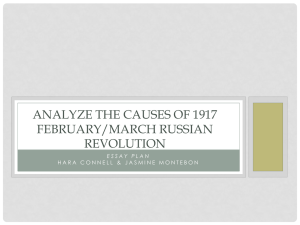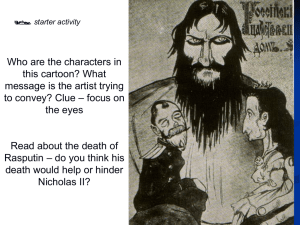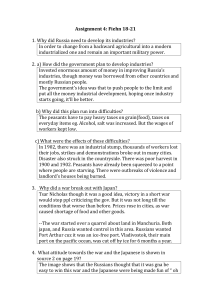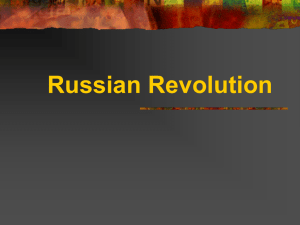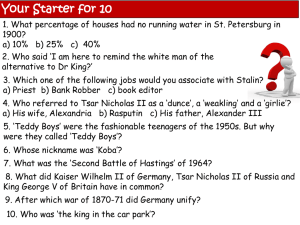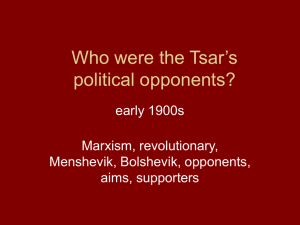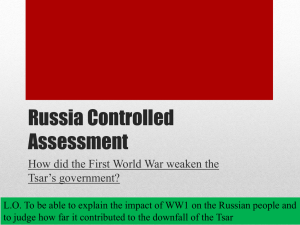Revolutionary Crisis Begins - vcehistory
advertisement
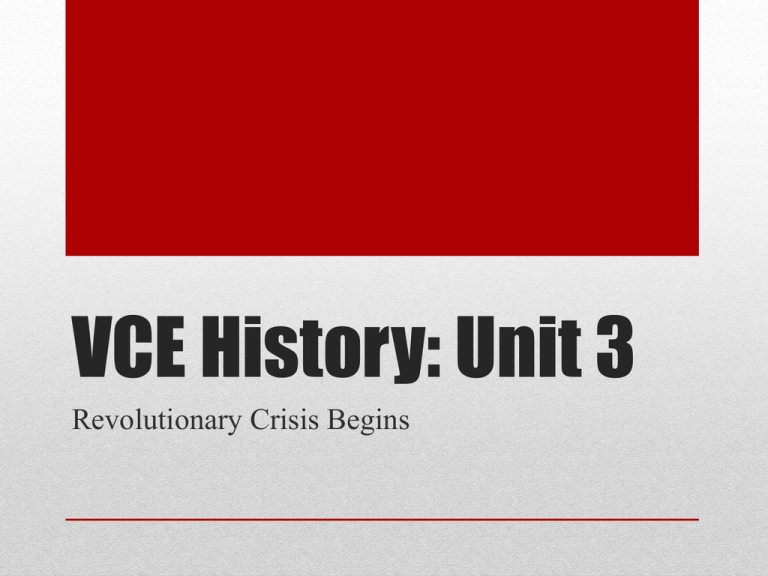
VCE History: Unit 3 Revolutionary Crisis Begins • Finance Minister Sergei Witte had an influence in creating a revolutionary situation. • The growth of industrialisation had attracted thousands of peasants to the industrial centres. • There had been a recession in 1899 and people had expectations of a better life. • These were not met due to poor living conditions and, later, a lack of jobs. • There was also the psychological and military weakness shown by Russia’s defeat to the Japanese in 1904-5. Revolutionary Discontent • Economic distress drove workers to action. The sacking of five men from the Pulitov Steel Works resulted in strikes of sympathy throughout the city, growing to 105,000 workers by Friday 7 January, 1905. • On a freezing Sunday morning on the 9th of January the largest strike in Russia’s history occurred. 111,000 men, women and children marched towards the Tsar’s Winter Palace in St Petersburg. Bloody Sunday Massacre • The Putilov strikes and the Sunday march were organised by Father Gapon, a priest from the Orthodox church and head of the Assembly of Russian Factory and Mill workers. • The marchers carried crosses and religious icons and sang ‘God save thy people’, carrying portraits of the Tsar and Tsarina. • The aim was to present a petition, signed by 135,000 workers, that outlined grievances and requested reforms. Gapon’s Petition 1) 2) 3) 4) 5) 6) Analysis Activity 1 • Reports vary on what happened when the groups joined together and reached the Winter Palace. • Gapon stated that they were confronted by the Tsar’s troops, along with the Cossacks. • Maxim Gorky (an influential socialist) witnessed the brutal death of a fellow worker. • The Tsar’s security police wrote that pleas to retreat were ignored, forcing the backlash by the police and cavalry. Confrontation • Nine days later the government published an account in Pravo (which means ‘Justice’) that claimed the petition contained ‘rude demands of a political nature’. • The government report declared that 96 had died and 333 were wounded but modern historians believe it was much higher. • The Tsar was criticised for not considering the requests ‘attentively and without anger’ but instead with violence. The Tsar’s initial response • This changed the public perception of Nicholas from the trusted ‘Little Father’ to the hated ‘Nicholas the Bloody’. • Cartoons in magazines, such as the British Punch, focused on his symbols of privileged royalty. • Some historians claim that the cause of the march was a rise in national consciousness due to urbanisation and improvement in literacy. • Others question this as the differences in material conditions (wealth/living conditions) and the limited and disjointed (sporadic) spread and acceptance of socialist ideas was not considered a likely cause of this united force. Changing perceptions • The march on the Winter Palace in January was the first of many. The most significant were the strikes in October 1905, which led to the Tsar promising reforms. • Other events included Battle of Tsushima (key defeat of Russia by Japan), mutiny of Potemkin (loss of support from armed forces), army troops mutiny on Trans-Siberian railway, establishment of All-Russian Union of Peasants in June and St Petersburg Soviet by Trotsky in October (development of resistant forces with representation). Key crises of 1905 • Powerful action provokes significant reaction. The economy was paralysed by strikes in Moscow and St Petersburg. • This forced a reluctant Nicholas to submit to demand for political reform. The Russian people wanted an elected government (the Duma) to represent them. • Nicholas responded with the October Manifesto which granted the establishment of a Duma and saved his regime from collapse. Tsar’s response 1) 2) 3) 4) Analysis Activity 2 • Tsar was reluctant about his own manifesto, drafted by Witte (Finance) and Obolensky (Education). He saw it as necessary to avoid further violence but at the risk of his autocracy. • Marxists claimed that the 1905 revolution showed that the tsarsdom was the ‘sworn enemy of the people’ and that only its removal would solve Russia’s problems. Trotsky said that the freedoms were invalid because of the restrictions of the military and censorship. ‘Everything is given and nothing is given’ Reactions to the Manifesto • Liberal opponents of tsarism (Octobrists and Kadets) had varying opinions. The Octobrists supported the reforms as an end to the conflicts. The Kadets compained that they did not go far enough. • Chemodanov’s cartoon ‘the lion, the bear and the rabbit’ infers an opinion by revolutionaries that the liberal ‘bourgeoisie’ parties were weak in pushing for reform and that the more radical Marxist parties were responsible for the ‘power of the proletariat’. Reactions to the Manifesto 1) 2) 3) Analysis Activity 3 1) 2) 3) 4) Practice Paragraph Answers Bloody Sunday (video) Nicholas & Alexandra (video)
